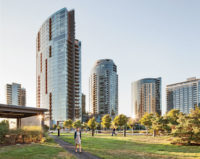New Orleans
2013 Population: 378,715
2010 Population: 343,829
2014 Median home price/sq. foot: $100
2011 Median home price/sq. foot: $105
2014 Median rent per month: $1,395
2011 Median rent per month: $1,065
2012 Percentage of renters spending more
than 35% of income on housing: 54.6%
Neal Morris has brought an entrepreneurial strategy to building affordable rental housing with his company Redmellon. "There are an estimated 40,000 vacant houses in New Orleans,' says Morris, who buys empty historic buildings and, with Atlanta-based Kronberg Wall Architects, renovates them using a combination of low-income-housing and historic-preservation tax credits, among other incentives. "I always say, I don't build housing for a living—I layer subsidies," he says. Morris makes the enterprise profitable by working in batches of 40 or so houses at a time, and he manages the completed portfolio, currently 300 rental units, through a separate company. The houses are primarily in desirable neighborhoods near the river, and the subsidies that Redmellon uses require that they remain affordable or low-income rentals for 15 to 35 years.
To make historically blighted but less expensive parts of town better places to live, the New Orleans Redevelopment Authority (NORA) has aimed to facilitate improvements on a neighborhood scale. 'Right after Katrina, we were focused almost exclusively on housing,' says NORA director Jeff Herbert. 'Now we're looking at longer-term transformation projects.' NORA's Lot Next Door Program, for example, helps residents acquire and maintain vacant land adjacent to their homes. The organization also provides financing and grants to jumpstart the revitalization of commercial streets.
To assure that improvement projects do not drive up housing costs, many in New Orleans have called on the city to provide protections for longtime residents. "Our stock of housing, close to jobs and to transportation, has always been a beautiful, historic commodity available to the local population. No one had to compete for it. But now there is a lot of pressure," says Maurice Cox, director of the Tulane School of Architecture's City Center and the former mayor of Charlottesville, Virginia. "I believe public policy can temper the market and protect people, but it's always a game of catch-up."
Rising housing costs are hardly unique to New Orleans, but here they touch on a particular anxiety. The city's culture'from second-line parades to Creole cuisine to historic architecture'is what attracts newcomers. Take away the social and economically diverse groups who maintain those traditions'a possibility made all too conceivable by Katrina's mass displacement'and all that remains are beautiful but empty streetscapes.
Back to In-Demand Cities

















